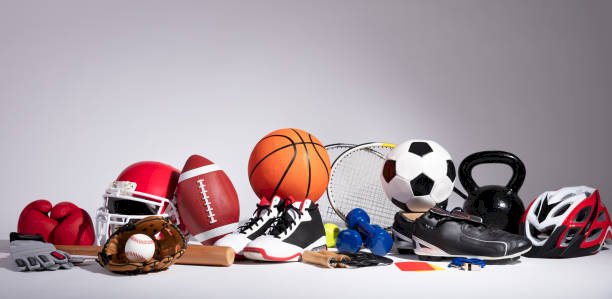Africa Sports Equipment and Apparel Market Expand at Steady CAGR of 4.5% During 2023–2029
BlueWeave Consulting, a leading strategic consulting and market research firm, in its recent study, expects Africa sports equipment and apparel market size to grow at a CAGR of 4.50% during the forecast period between 2023 and 2029

BlueWeave Consulting, a leading strategic consulting and market research firm, in its recent study, expects Africa sports equipment and apparel market size to grow at a CAGR of 4.50% during the forecast period between 2023 and 2029. The popularity of sports and fitness among young people, rising consumer awareness of fitness, rising adoption of new sports technologies, and the emergence of fashion trends are all major factors propelling the growth of the Africa sports equipment and apparel market. It is expected that increased participation from various organizations in the donation of sporting equipment to new sports enthusiasts and athletes from disadvantaged backgrounds will create abundant opportunities for industry expansion.
Africa Sports Equipment and Apparel Market – Overview
The clothing worn for physical activity or sport is known as sports apparel. Activewear or sportswear are other names for it. Sport-specific clothing is required for the majority of sports and physical activities for practical, comfortable, or safety reasons. Sport-specific attire includes things like tracksuits, shorts, T-shirts, and polo shirts. Leotards, ski suits, wet suits for diving or surfing, swimsuits, and ski suits are a few examples of specialized gear (for gymnastics). Sports footwear includes skates, football boots, riding boots, and trainers. Sometimes people dress casually in sportswear. As the economy and the value of money develop, people are searching for the best choice among the numerous brands that are offered. As a result, in response to product demand, the sports products industry is constantly expanding. The sportswear industry has enormous commercial potential, particularly in marketing, management/sponsorship, and sporting goods sales and export.
Sample Request @ https://www.blueweaveconsulting.com/report/africa-sports-equipment-and-apparel-market/report-sample
Growth Drivers
Increasing Use of Technology
Due to a variety of technological applications, sports players and coaches are learning more about player performance and techniques. Promotional tactics, such as non-personal communication through the media and sales promotions, like coupons, discounts, stamp redemption, free samples, and memberships for motivating customers, are some of the efficient tools that are significantly boosting the market. Along with sponsorship and event promotion, interactive marketing also contributes to the game's and the associated equipment's increased popularity. The goals of these marketing campaigns are to generate interest, pique curiosity, stoke desire, and motivate consumers to play the game.
Challenge: Lack of Uniform Standards
Various standards govern the design of various sports equipment. For example, in the tennis equipment market, standards are required for grip size, string area, racquet or frame length, racquet or frame mass, and moment of inertia. The racquet's length, including the handle, must not exceed 29 inches (73.66 cm), and its width must not exceed 12.5 inches (31.75 cm). The hitting surface should be no wider than 11.5 inches (39.37 cm) and no longer than 15.5 inches (39.37 cm) (29.21 cm). These requirements make it difficult for manufacturers, slowing the growth of the sports equipment market.
Impact of COVID-19 on Africa Sports Equipment and Apparel Market
The sports and fitness industry has suffered as a result of the Covid-19 pandemic. The Olympics was one of many contests and sporting events that had been postponed or had their formats altered. To understand how disruptions in financial flows, uncertainties, and anticipated losses would impact the long-term outcome, market participants tried to predict these factors. The Covid-19 outbreak hurt the market for sporting goods because sports participation has decreased. The market has, however, returned to its pre-COVID-19 growth status as a result of the resumption of sports activities and the relaxation of international sport travel restrictions.
Africa Sports Equipment and Apparel Market – By Distribution Channel
The sports apparel and equipment market in Africa is split into online and offline segments based on the distribution channel. The offline segment held a higher market share and is expected to continue dominating the market throughout the forecast period. The offline market is growing as a result of the increasing popularity of stores, hypermarkets, and specialized showrooms that sell products from well-known international brands like Adidas, Nike, and others. The segment's expansion is attributed to options like discounts and free trials before purchases, as well as the benefit of instant gratification. The online segment is predicted to grow at a higher CAGR during the forecast period. More people are using the internet and their smartphones to shop online and compare products and prices, which is driving the market.
Competitive Landscape
Africa sports equipment and apparel market is fiercely competitive. Prominent players in the market include ADIDAS AG, Puma, Nike, Adidas, Reebok, ASICS, Under Armour, Lacoste, Columbia, Decathlon, New Balance, SALOMON, Decathlon, Converse, and Umbro. companies use various strategies, including increasing investments in their R&D activities, mergers, and acquisitions, joint ventures, collaborations, licensing agreements, and new product and service releases to further strengthen their position in Africa sports equipment and apparel market.
Contact Us:
BlueWeave Research Blog
Phone No: +1 866 658 6826
Email: info@blueweaveconsulting.com

























